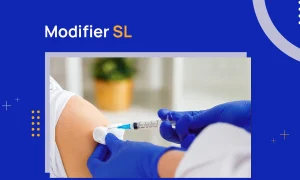Performing nail debridement may seem straightforward, but billing for these procedures is definitely not! Trying to bill CPT code 11721 presents unique challenges, from establishing medical necessity beyond routine care to applying the correct Q modifiers for Medicare patients.
Additionally, errors such as billing for the wrong nail count, insufficient documentation, or non-compliance with frequency limits often lead to revenue leakage.
This comprehensive guide unravels the complexities of CPT 11721. It will help you master the nuances of nail debridement coding and secure accurate reimbursement.
So, without ado, let’s get started!
CPT Code 11721 – Description
CPT code 11721 covers surgical debridement of six or more infected, abnormal, or diseased nails. It is from the code range ‘Surgical Procedures on the Nails’. Like all other procedural code ranges, the American Medical Association (AMA) maintains it.
Understanding the descriptor is a critical step when billing for procedures because minor details matter. For instance, code 11721 mentions six or more nails, which means you should not report it if the physician removed fewer than six nails. Why? Because there is another more relevant code available for it, i.e., CPT 11720.
Scenarios Where CPT Code 11721 is Applicable
Here, let’s take a look at a few real-world clinical scenarios where CPT code 11721 applies:
Severe Onychomycosis
Picture a 54-year-old female patient who visits a podiatrist with a severe, long-standing onychomycosis (fungal nail infection) affecting all ten toenails. This infection resulted in discolored, thickened, and brittle nails. Moreover, she complains of experiencing pain while wearing shoes.
Since the condition is so severe that self-care can make no difference in the patient’s condition, the podiatrist surgically debrides all ten dystrophic nails (CPT code 11721). He uses a rotary burr and nippers to reduce the thickness and remove infected material.
Traumatic Nail Dystrophy
Consider a 43-year-old male marathon runner. He comes to the podiatry clinic with chronic thickening and dystrophic changes to seven toenails. The condition worsened due to repetitive microtrauma from running shoes.
He exclusively visited the podiatrist because the nails were causing pain, and recurring subungual hematomas (collections of blood underneath the nails).
As a result, the podiatrist surgically debrides the seven affected toenails (CPT code 11721).
Functional Impairment Due to Onychauxis
Consider an 80-year-old male bed-bound patient. He has developed marked onychauxis (overgrowth and thickening of nails) on six of his toenails.
The nails have become so hard and thick that they cause pressure sores on adjacent toes. As a result, it has become impossible for home health aides to assist with footwear.
Therefore, the podiatrist surgically debrides the six affected hypertrophic nails (CPT code 11721).
Applicable Modifiers for CPT Code 11721
Not sure which modifier to append when billing for a nail debridement procedure? Not anymore! Discussed below are all the applicable modifiers for CPT code 11721:
Modifier 59
What happens when the podiatrist performs two distinct procedures on the foot on the same day? You append modifier 59 to CPT code 11721 to indicate it is a significant and separate service. It helps bypass NCCI edits and ensure accurate reimbursement for both procedures.
Modifier Q7, Q8, Q9
It is integral to append any one of the modifiers Q7, Q8, and Q9 while reporting nail debridement procedures, such as CPT code 11721. It ensures coverage of routine foot care by Medicare since the patient has a qualifying systemic condition. Here’s what these modifiers indicate:
| Modifier | Description |
|---|---|
| Q7 | One (1) Class A finding |
| Q8 | Two (2) Class B findings |
| Q9 | One (1) Class B finding and two (2) Class C findings |
However, note that you do not need to append these modifiers if the patient has evidence of neuropathy, but no vascular impairment.
F/T Modifiers
Ever wondered, you performed debridement for six or more nails, but how can you specify to the payer which toenails or fingernails? It is a valid question, since payers, including Medicare, emphasize coding accuracy and specificity.
Well, no need to worry, because we have F/T modifiers available specifically for this purpose. Check out the table below, and report the modifiers accordingly to avoid any stone unturned while reporting CPT code 11721:
| Finger Modifiers | Description | Toe Modifiers | Description |
|---|---|---|---|
| FA | Left hand, thumb | TA | Left foot, great toe |
| F1 | Left hand, second digit | T1 | Left foot, second digit |
| F2 | Left hand, third digit | T2 | Left foot, third digit |
| F3 | Left hand, fourth digit | T3 | Left foot, fourth digit |
| F4 | Left hand, fifth digit | T4 | Left foot, fifth digit |
| F5 | Right hand, thumb | T5 | Right foot, great toe |
| F6 | Right hand, second digit | T6 | Right foot, second digit |
| F7 | Right hand, third digit | T7 | Right foot, third digit |
| F8 | Right hand, fourth digit | T8 | Right foot, fourth digit |
| F9 | Right hand, fifth digit | T9 | Right foot, fifth digit |
CPT Code 11721 – Billing & Reimbursement Guidelines
We have successfully covered a decent amount of detail about what CPT code 11721 is, where it applies, and what modifiers to append. It is now time to discuss the essential billing and reimbursement guidelines:
Demonstrate Medical Necessity
Medicare and other commercial payers do not cover routine foot care that involves nail debridement for cosmetic reasons. Therefore, it is critical to demonstrate and support medical necessity in your documentation.
For Medicare-enrolled patients, you can receive reimbursement for nail debridements (CPT code 11721) if the patient has a qualifying systemic condition. These conditions include:
- Diabetes mellitus with neuropathy or peripheral angiopathy.
- Arteriosclerosis, chronic venous insufficiency.
- Chronic kidney disease, severe peripheral vascular disease, or certain neurological conditions.
However, you must append a relevant Q modifier (Q7, Q8, or Q9) to ensure coverage.
Do Not Bill It for Fewer than 6 Nails
You should not report CPT code 11721 when the provider removes fewer than six nails because it will result in claim denial due to overcoding. There is another, more specific CPT code, 11720, available to report when the physician debulks five or fewer nails.
Meet the Documentation Requirements
Remember that your documentation serves as the evidence as to why you are billing CPT code 11721 or appending a modifier. Besides, it is also the key to supporting medical necessity.
Therefore, you should always take the time to ensure your documentation is complete. Besides, each patient visit has a detailed subjective, objective, assessment, and plan (SOAP) note.
Here’s what should be there in the documents:
- Patient symptoms, such as pressure, pain, difficulty ambulating, or signs of infection.
- Objective findings that include details of the nails. For instance, their discoloration, thickness, presence of ingrown components, or deformity. Include relevant physical examination findings for systemic conditions, including sensation, pulses, and skin integrity, for a diabetic patient.
- State the diagnosis with specific ICD-10-CM codes that support the need to perform the surgical debridement, e.g., fungal infection.
- Explain in detail the method and the nails that the physician removed, e.g., left foot, great toe.
Final Thoughts on CPT 11721
Congratulations on reaching the end of this comprehensive guide! Now you know that you can only bill CPT code 11721 when the podiatrist debulks six or more nails. Also, payers will not compensate for it when done for cosmetic reasons.
Hopefully, the things we discussed will help you navigate debridement-related billing challenges and denials. However, if you need professional help, feel free to explore NeuraBill’s podiatry billing services.
FAQs
How often can 11721 be billed?
According to CMS guidelines, you can bill CPT code 11721 once every 60 days. That is, it is limited to 6 sessions per beneficiary annually.
Does CPT 11721 require a modifier?
You may append modifier Q7, Q8, or Q9 when the coverage is based on the presence of a qualifying systematic condition.
You may append modifier Q7, Q8, or Q9 when the coverage is based on the presence of a qualifying systematic condition.
Is CPT 11721 covered by Medicare?
Medicare covers the surgical debridement if it is medically necessary. That is, your claim must contain the ICD-10-CM code B35.1 with other relevant codes indicating secondary pain, infection, or ambulation.
What is the difference between G0127 and 11721?
CPT code 11721 covers the debridement of six or more nails by any method. Contrarily, G0172 involves trimming of dystrophic nails, any number.
Can you bill 11721 and 11719 together?
No, you cannot bill CPT codes 11721 and 11719 together because the former includes the trimming of nails as part of the debridement, making 11719 redundant.



